11 Trees that Grow in Shade (with Pictures)
-
Greg Iacono
- Last updated:

One of the greatest aspects of having a nice property is displaying beautiful trees in your yard. Trees add life, depth, and beauty to any green space and provide much-needed shade. However, one challenge for homeowners is when their yard is already shaded. If that sounds like your property, and you want to plant more trees, you will need trees that grow in less sunlight.
The good news is that we’ve finished the searching for you and have 11 trees that grow in the shade below.
Before purchasing any trees on today’s list, it’s best to determine how much shade they will receive when placed in your yard. There are five variations of shade, including:
- Light shade (4–7 hours of sun)
- Partial (semi) shade (3–6 hours of sun)
- Dappled shade (Light filtered through other trees)
- Moderate shade (2–3 hours of sun)
- Deep shade (Less than 2 hours of sun)
The 11 Trees that Grow in Shade
1. Flowering Dogwood
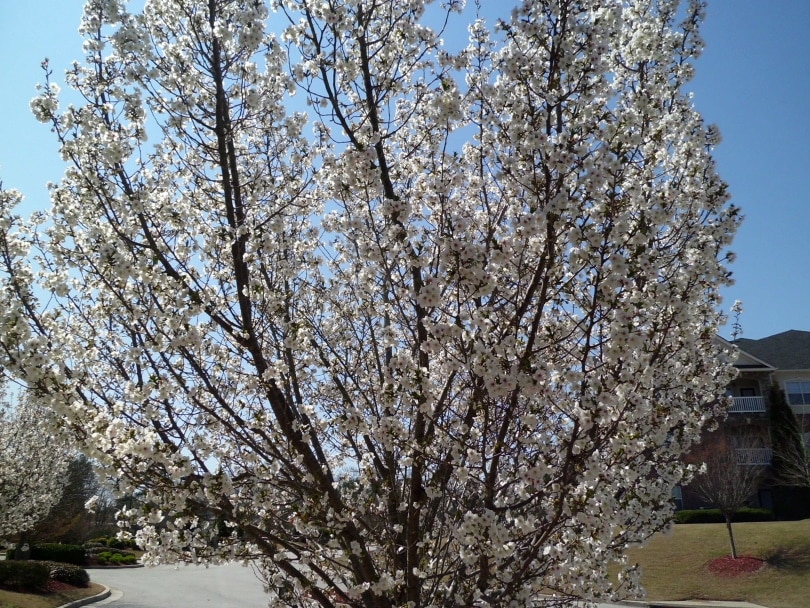
| USDA Hardiness Region: | 5 to 9 |
| Tree Height: | 15–20 feet (5–6 meters) |
| Shade Preference: | Light shade |
The flowering dogwood is a popular ornamental tree in the United States and the United Kingdom. One reason is that it’s a low-maintenance tree and demands very little from its owner. Also, flowering dogwoods produce gorgeous flowers and ornamental berries every year. In other words, they bring extra color to the shady area of your yard.
More than that, flowering dogwoods can handle various soil types. There are two varieties to choose from, including Cornus kousa schmetterling, which has a thick covering of white flowers, and Cherokee daybreak, which has pink blooms instead of white. Flowering dogwoods grow best in light shade.
2. Japanese Maple (ACER)
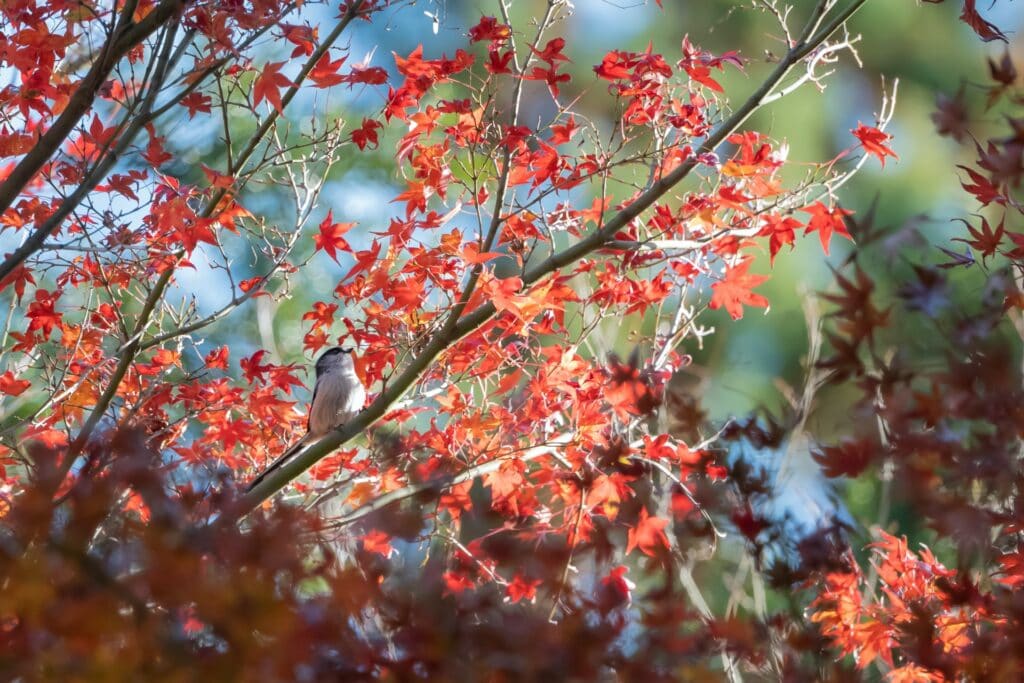
| USDA Hardiness Region: | 5 to 8 |
| Tree Height: | 15-25 feet (5-7 meters) |
| Shade Preference: | Dappled, moderate, and deep shade |
If you’re looking for a tree with beautiful foliage and attractive shapes that grows well in the shade, the Japanese Maple is a grand choice. Some people refer to them as “Acers.” Another reason to choose a Japanese Maple is that they work perfectly in small areas, and many homeowners use Japanese maples in their front yards.
While they grow best in dappled shade, Japanese maples can also handle moderate and deep shade. One thing you might notice, however, is that the red Japanese maple color will be greener if the tree has less light. However, its beautiful fall colors will still be as vibrant.
3. Irish Yew
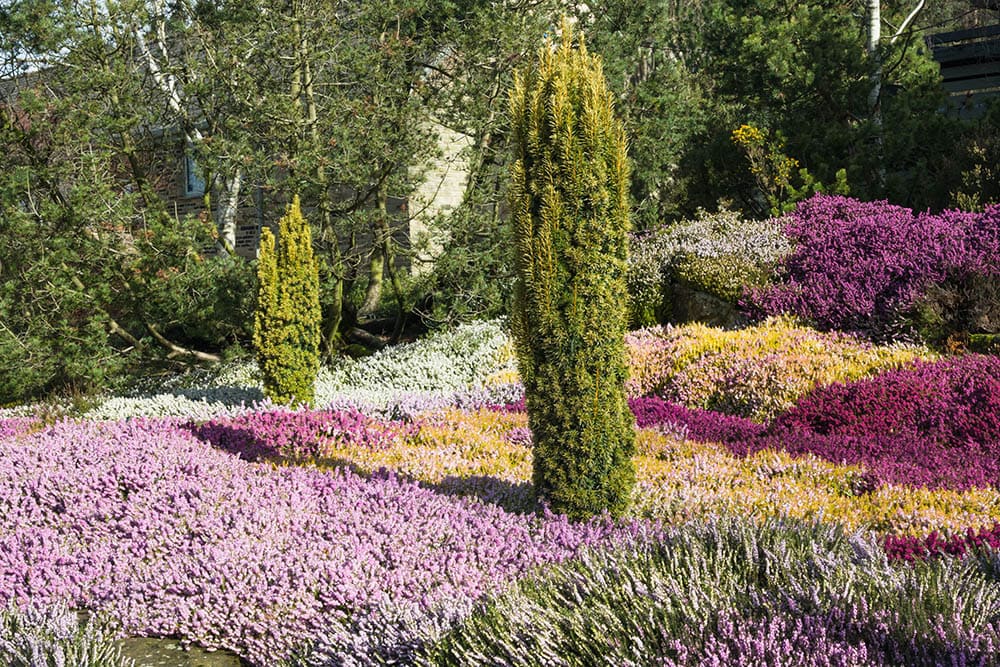
| USDA Hardiness Region: | 5 |
| Tree Height: | 18-23 feet (6-8 meters) |
| Shade Preference: | Heavy shade |
An evergreen conifer tree, the Irish yew can grow up to 23 feet (7 meters) tall. Many homeowners find their column-like shape very elegant and appealing, but besides a dark green, yews aren’t very colorful. In the fall, however, female Irish yews sport attractive red berries. Tree experts say that if you have a dark corner in your garden, the golden version of the Irish yew can lighten it up significantly.
One important note for families with children and dogs is that the Irish yew is highly toxic. In fact, it’s one of the most toxic plants for dogs and cats and, if eaten, can kill them. On a lighter note, the Irish yew grows best in heavy shade. Also, its cousin, the Japanese yew, shares many of its traits.
4. Portuguese Laurel

| USDA Hardiness Region: | 6 to 9 |
| Tree Height: | 15-20 feet (5-7 meters) |
| Shade Preference: | Partial shade |
Are you looking for a tree that grows in shade and also gives you a lot of privacy? If so, the Portuguese Laurel is ideal. Its leaves are glossy, evergreen, and quite dense. One interesting fact about the Portuguese Laurel is that it grows well in partial shade even though it’s a flowering tree. Usually, flowering trees need a lot of light.
You’ll see thousands of tiny white flowers on your Portuguese Laurel in spring, but you won’t see any deer near the tree because it’s resistant to them. Also, it’s a low-maintenance tree and typically requires a single annual trim. Portuguese Laurels will grow quickly, but you can down their growth by trimming them more often.
5. American Hornbeam
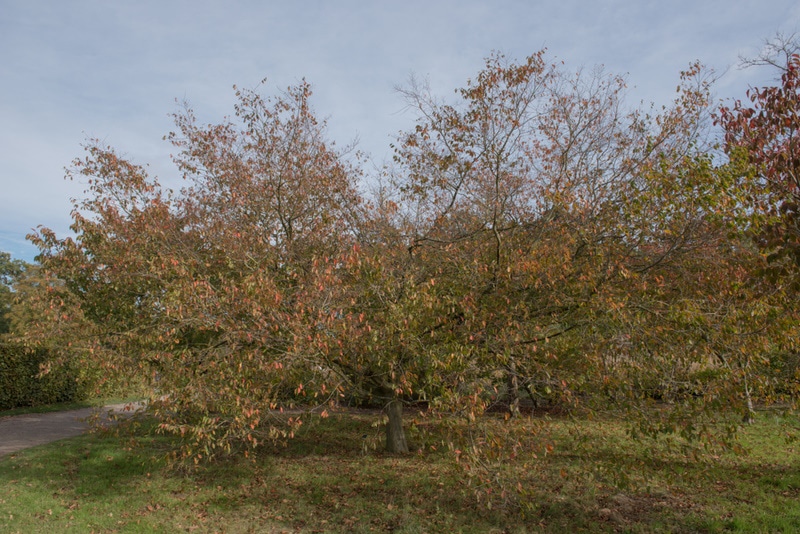
| USDA Hardiness Region: | 5 to 9 |
| Tree Height: | 20–40 feet (6-12 meters) |
| Shade Preference: | Heavy shade |
Since it’s native to east-coast American forests, the American hornbeam is one of the best trees to grow in shady areas. In the forest, hornbeams typically grow below other trees where heavy shade is all they get. After millions of years of growing this way, the American hornbeams should not have any issues growing in a shady yard.
They also happen to be attractive trees with bright, green leaves. However, in fall, the American hornbeam truly shines when its leaves become a blaze of orange, red, and yellow.
6. Allegheny Serviceberry
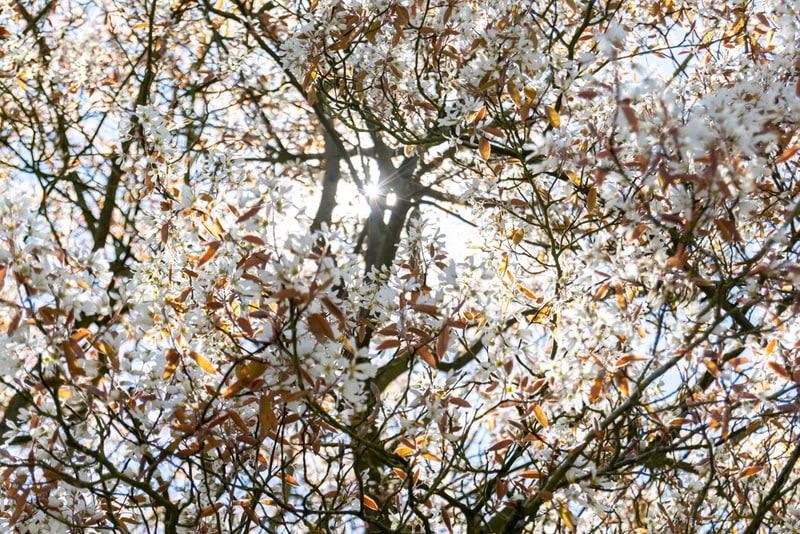
| USDA Hardiness Region: | 4 to 8 (9 possibly) |
| Tree Height: | 30–40 feet (9–12 meters) |
| Shade Preference: | Partial or Heavy shade |
The Allegheny serviceberry is one of the few tree species that prefer partially and fully shaded areas. However, they seem to do best in deep shade.
In spring, the Allegheny serviceberry comes to brilliant life with a massive amount of beautiful white flowers. It’s a medium-sized tree that produces purple fruit in the summer that’s appealing to birds. It will be one of the most attractive trees in your yard when it blooms.
7. Eastern Redbud Tree
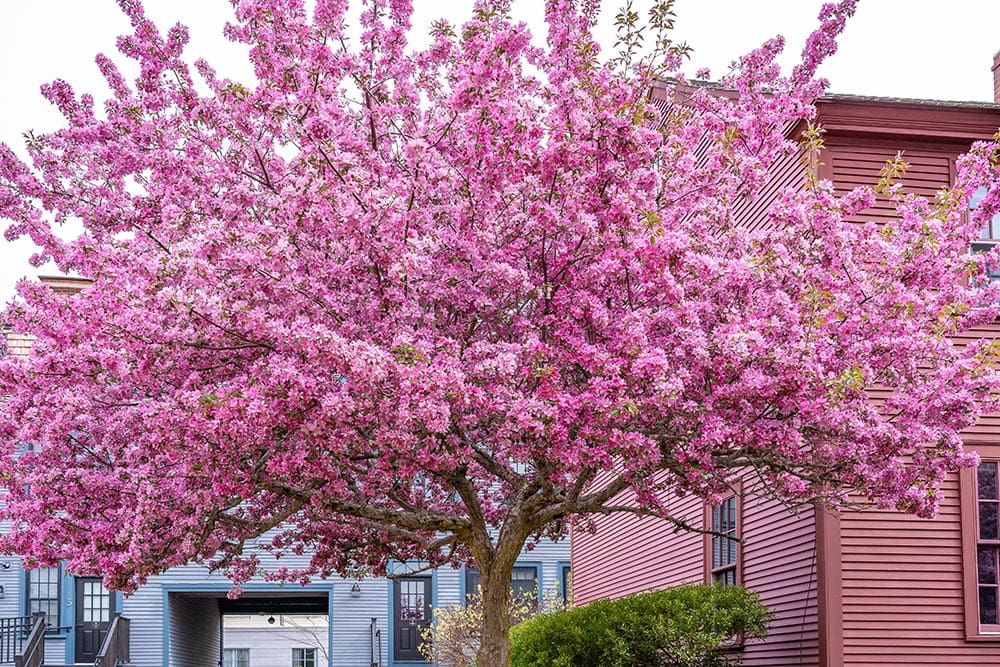
| USDA Hardiness Region: | 4 to 9 |
| Tree Height: | 10–20 feet (3–6 meters) |
| Shade Preference: | Heavy shade |
Does the dark and gloomy part of your yard need a splash of color every spring? If so, the Eastern redbud tree is a fantastic choice. It produces a prolific amount of flowers in a pale pink and purple color that’s truly gorgeous.
Even though it’s a deciduous tree, it turns yellow to add another bright spot to that dark corner of your yard in the fall. If white flowers are more your style, try the redbud’s close relative, the Alba Judas tree. The Eastern redbud tree grows best in partial shade and needs well-draining soil.
8. Variegated Holly
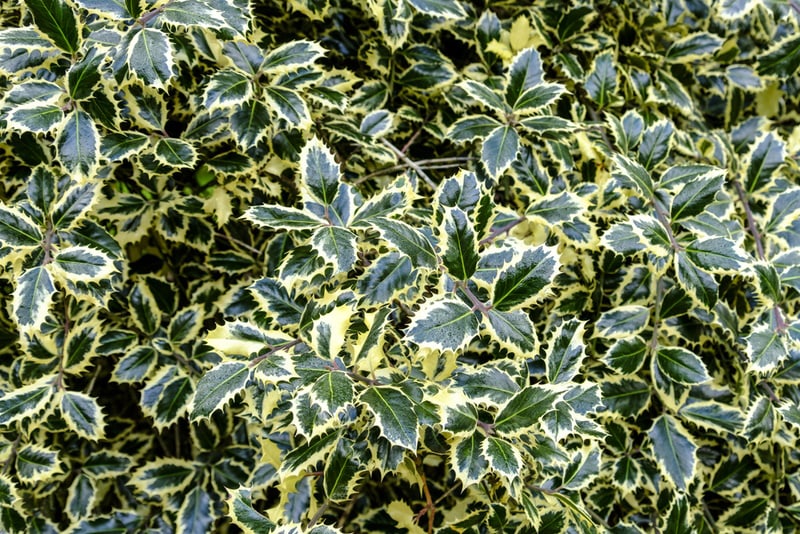
| USDA Hardiness Region: | 5 to 9 |
| Tree Height: | 15–40 feet (4.5–12 meters) |
| Shade Preference: | Partial to Heavy shade |
Although it’s not the exact holly people associate with the holidays, variegated holly has more of those gorgeous red berries. One caveat, however, is that only females produce the berries when they’re pollinated by a male variegated holly tree. That’s why it’s recommended to plant a male and female Variegated Holly tree together. Some growers have started selling male and female pairs in a single pot.
A variegated holly tree grows best in partial shade but can also do well in deep shade. However, the leaf coloration may change. There are several varieties of holly trees to choose from, and they all have unique leaf colors.
9. Katsura Tree

| USDA Hardiness Region: | 4 to 8 |
| Tree Height: | 120–150 feet (37–46 meters) |
| Shade Preference: | Partial and Dappled shade |
The Katsura tree, often called the “candy floss tree,” is gorgeous from spring to the end of fall. In spring, it produces pink leaves, but the color changes to a beautiful light green in summer. In fall, the tree’s color changes again to yellow and orange.
The Katsura tree Grows best in partial shade and dappled shade, and it’s a wonderful addition to any part of your yard. However, it prefers a shelter from the wind when young and is a better fit for a large garden. When full-grown, the Katsura tree can reach upwards of 39 feet (12 meters) in height and 26 feet (8 meters) in width!
As for why they’re sometimes called the candy floss tree, it’s because the Katsura tree’s heart-shaped leaves smell like cotton candy!
10. Big-Leaf Maple

| USDA Hardiness Region: | 5 to 9 |
| Tree Height: | 50–80 feet (15–20 meters) |
| Shade Preference: | Heavy shade |
The big-leaf maple is a massive tree and one of the few on our list that thrives in dark and sunny areas. Maples can grow to 75 feet tall and higher! The name, big leaf, comes from the tree’s ability to grow incredibly large leaves, up to 2 feet in width.
One important note about big-leaf maples is that they need a large amount of water. An area with a lot of rain is perfect, but if not, big-leaf maples should be watered regularly.
11. Eastern Hemlock
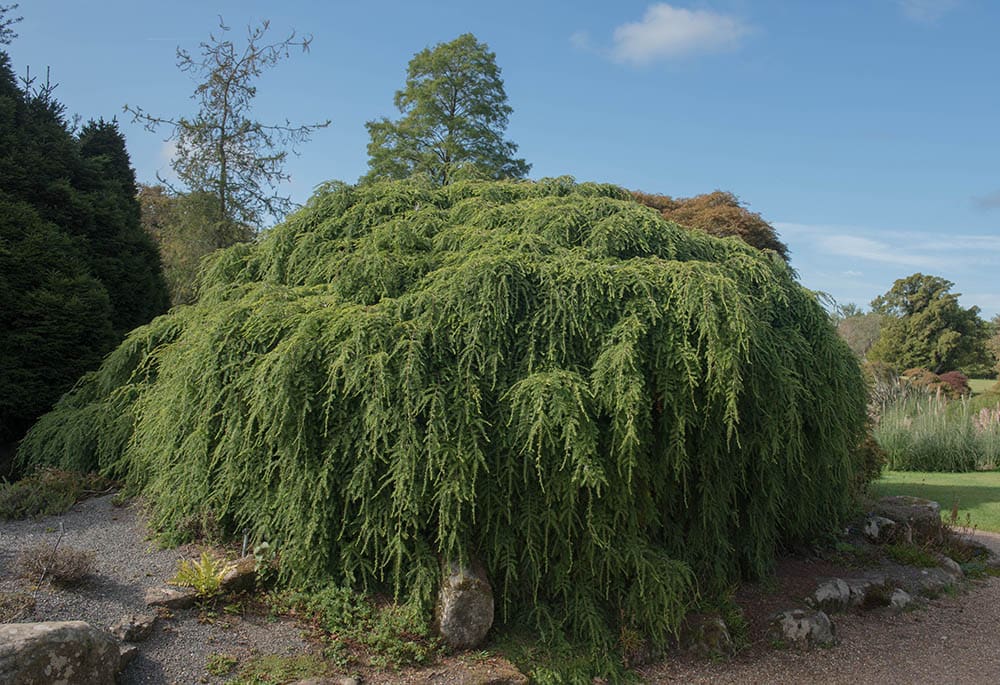
| USDA Hardiness Region: | 3 to 8 |
| Tree Height: | 80–100 feet (20–30 meters) |
| Shade Preference: | Light to Heavy shade |
It’s unusual for an evergreen tree to grow well in shade, but the Eastern hemlock can handle full shade if necessary. Not only that, but the Eastern hemlock looks amazing, whether in shade or sun. Its leaves look similar to a feather, and the Eastern hemlock has graceful, lacy twigs that droop beautifully.
They are big trees and demand a big yard, growing as tall as 50 feet. As a side note, in the Adirondack Mountains, the Eastern hemlock is the only hemlock that grows natively. Also, its crushed foliage smells similar to the poisonous hemlock herb, which is where this beautiful tree got its name.
Conclusion
If you have areas in your yard, big or small, that don’t get a lot of light, all of the trees on our list will thrive in shady yards. Some need more light than others, but all these trees grow in the shade and look beautiful doing so.
Remember to choose a tree that’s suitable for the amount of shade of your yard as well as the size of your property. Some species, like the big-leaf maple, are simply too big for small spaces. Best of luck growing all of these wonderful trees in your yard!
Featured Image Credit: Nick Fewings, Unsplash
Contents
